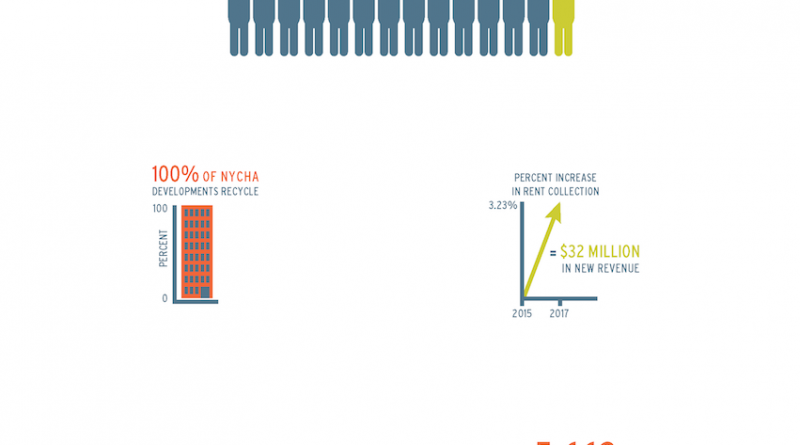Next Generation NYCHA: Two Years of Progress
For 83 years, NYCHA has been a quintessential part of New York City. Today we house one in every 14 New York residents. Many work for some of the City’s greatest institutions as nurses, public school teachers, and police officers.
For 83 years, NYCHA has been a quintessential part of New York City. Today we house one in every 14 New York residents. Many work for some of the City’s greatest institutions as nurses, public school teachers, and police officers. NYCHA adds billions of dollars to the city’s economy every year.
In May 2015, NYCHA launched NextGeneration NYCHA, 10-year strategic plan to preserve and protect public housing for current residents as well as the next generation of New Yorkers. Our plan outlined a roadmap to safe, healthy, connected homes and communities for NYCHA residents.
We have made significant progress on our goals and can continue to do so if we receive adequate funding from the US Department of Housing and Urban Development (HUD) which provides most of the funding for public housing. Unfortunately, the cuts that the Trump administration has proposed for HUD would result in a $220 million (68%) cut to NYCHA’s capital budget and a $100-$150 million (13%) cut to our operating budget.
Here’s what these cuts will mean to NYCHA:
Fewer frontline employees taking care of the developments day in and day out;
Slower service: going back to the days where basic maintenance took 137 days and getting your sink fixed took 13 days;
Fewer building repairs and more deterioration of NYCHA buildings and apartments;
No boiler improvements, elevator upgrades, building exterior work or replacement of kitchens and bathrooms;
Lost NYCHA union jobs and big cutbacks to our resident and economic development programs, which provide opportunities to 10,000 residents a year;
And elimination of 7,500 Section 8 vouchers.
Poor housing conditions contribute to poor health, especially among seniors, children and the disabled. These cuts will hurt the health and welfare of NYCHA residents, including the 47% of our residents who are seniors and children. What’s more, research shows that the single most cost-effective strategy for reducing childhood poverty is access to affordable housing. When people have affordable housing, they can spend nearly five times more for healthcare, a third more on food, and twice as much on retirement savings. They can pay down debt, save for college, or even buy a home.
What can you do?
Become informed about the proposed HUD cuts and what housing advocates are doing.
Contact your elected officials at the local, state and national level and tell them how you feel about protecting and preserving public housing. To find out who your elected officials are, visit mygov.nyc.gov or call the League of Women Voters at (212) 725-3541.
Join your resident association and community board and participate in policy and program discussions that impact your development and your neighborhood. Attend meetings organized by advocates and elected officials to speak out about public housing.
For more information about affordable housing, you can visit the websites of the US Department of Housing and Urban Development, the National Low Income Housing Coalition, the National Association of Housing and Redevelopment Officials, and the Fair Housing Justice Center.
NextGeneration NYCHA Accomplishments 2015-2017
THE FACTS
176,066 public housing apartments in 2,462 buildings in 326 developments
590,216 New Yorkers (one in every 14) live in NYCHA public housing or use NYCHA Section 8 vouchers
8.1 percent of the City’s rental housing is public housing and apartments rented with NYCHA Section vouchers
NYCHA = Miami in population size
$509 = average monthly public housing rent
43 percent of residents come from 145 other countries
47.1 percent of NYCHA families are working
20 percent of residents are 62 or older
27 percent are under age 18
Fund
3.23 % increase in rent collection = $2,013,536 in new revenues for repairs
19 new ground floor leases = $661,000 collected since May 2015 for repairs
Operate
677,000 work orders closed using digital equipment.
$1,200,000 in savings from deployment of smart phones to property management staff
$960,000 in savings since MyNYCHA debited October 2015
100 % of NYCHA developments recycle
$3.5 million in energy savings every year from our first Energy Performance Contract $460 million in Sandy recovery construction underway at 45 buildings in progress
67 roofs will be replaced by the end of 2017
Rebuild
1,419 units of 100 percent affordable housing in development
800 projected units for NextGen Neighborhoods (50 percent affordable, 50 percent market rate)
1,400 units at Ocean Bay Bayside will be renovated under the RAD program, benefitting over 3,700 residents
$300 million generated by this project for repairs at 17 other developments
Engage
50 new Resident Associations
10 new Youth Councils
7,500 connected to social services through community partnerships
5,663 residents placed in jobs
646 residents enrolled in NYCHA Resident Training Academy
4 urban farms, 12,394 pounds of produce in 2016

